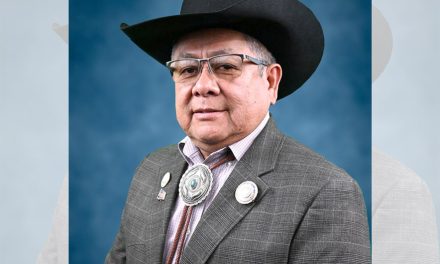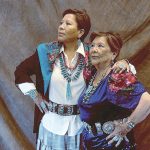
50 Years Ago: Taking a look at how life changed in 25 years
The BIA has done a wonderful job of making positive changes to the lives of the Navajo people in the past 25 years, according to some Navajos. But about the same number of Navajos argue that the BIA has done nothing positive.
In what is a “this is the best of years, this is the worst of years” scenario, the Navajo Times at the end of 1970 and into 1971 explored the question of how life has changed for the Navajo people since the end of World War II.
There’s no question that for tens of thousands of Navajos, their lives were changed substantially as the reservation started reforming due to the influence of the surrounding world. But for many Navajos living in remote places like Big Mountain, their lives for the most part remained much the way they had been for generations.
Dick Hardwick, the managing editor of the Times, began looking into this subject in his weekly column, which was picked up by his successor, Chet MacRorie, when he took over. Hardwick used his personal knowledge as well as information provided in the books the BIA put out every year marking their progress in improving the lives of the Navajo people.
First, let me acquaint you with these books because many Navajos living during those years probably had no idea these annual reports were coming out. The BIA started publishing these reports in book form sometime in the 1950s and stopped doing them in the late 1960s.
These were actual books with soft covers and anywhere between 200 and 300 pages. They looked and read like books and it was evident that BIA employees spent hundreds of hours, maybe even thousands, researching and writing the text.
They were available to the public but there was no attempt to make the writing interesting or a joy to read. There were no anecdotal stories of life in the reservation. It was basically a recitation of the facts written in such a way as to convince readers the BIA was doing a good job.
Copies of these books are occasionally available online and usually they only go for $15 to $25 although I have seen people try to sell them for as much as $250 thinking there is a demand for them and that they are very rare. I don’t know for sure how many copies of these books were printed.
Hardwick once guessed the BIA printed a few hundred, with most going to the various BIA offices and to tribal officials.
]The Navajo Tribal Library in Window Rock has a full collection of them so if you are doing research of areas like education, economic development, mining and tribal government between 1945 to 1970, these make excellent sources as long as you recognize that the writing contains a bias.
I have never compared the books so I don’t know if certain sections were copied in part or in whole from one book to another. But given the fact that the books were put out every year makes me think that was probable.
You also have to remember that Hardwick was part of the BIA when he was managing editor of the Times. He had been working in tribal relations for the BIA in 1967 when then chairman Raymond Nakai asked that he be assigned to run the newspaper because he wanted someone there who wouldn’t go after him. He got this with Hardwick who didn’t publish any negative arguments against Nakai, although he was not reluctant to print letters to the editor that were critical of Nakai and his programs.
Although he was on assignment from the BIA and went back to his old position when he stepped down from the Times, occasionally he would take the BIA to task for something they did or didn’t do. He took the information given in the annual reports as accurate knowing that BIA officials saw nothing wrong with using the facts to their benefit. They would not change the facts to put them in a positive light.
MacRorie didn’t rely on the books but had his reporting staff – yes, the Times finally had the money to hire reporters – do surveys and interview elderly Navajos about how their life had changed during the past 25 years.
What both Hardwick and MacRorie discovered was that the paving of roads as well as a shift from horse-drawn wagons to cars and pickups made it possible to travel off the reservation whenever they wanted. And as the years went by, they wanted to do so more and more.
The trips didn’t make any major change in how they viewed life but it did on their children, Hardwick said. Navajo children saw first-hand how kids their age off the reservation lived and started asking their parents for things that off-reservation children had, from bicycles to music boxes. They began going with their parents into town on a weekly basis so they could go to movies and fast-food restaurants.
Over the years, their view of life underwent a major change, the two Times editors would write, forever changing life on the reservation. But the annual reports talked about a different culture in remote parts of the reservation where families didn’t have the same benefits as those who lived close to border towns and had running water and electricity.
The reports went into detail that people in these remote communities, many of them within the Navajo-Hopi Land Dispute area, weren’t able to travel because of bad roads and other factors. Their children weren’t as influenced as their counterparts in areas where it was possible to go off the reservation more frequently.
Another thing the reports indicated was an economic difference that may have had even a bigger effect. Because of the lack of jobs, the prevailing industry in these communities was rug weaving and silversmithing. And unless you were a master weaver or a silversmith whose work was highly praised or collected, your income was affected by the market and by how much the dealers would pay for your work.
For all of those years, the arts and crafts industry was small. Therefore prices paid by the dealers weren’t much. In many cases, craftspeople had a hard time making even minimum wage. That all changed, of course, in the early 70s when the boom in Indian jewelry began with movie stars and celebrities wearing Indian jewelry as a fashion statement and women throughout the country followed suit.








 Highway 264,
Highway 264, I-40, WB @ Winslow
I-40, WB @ Winslow